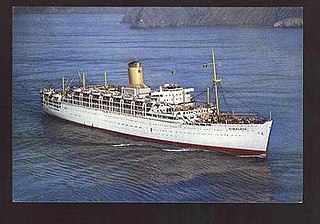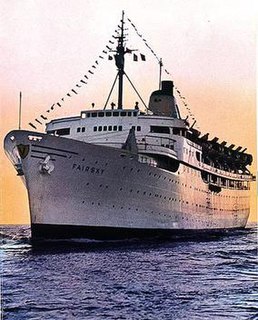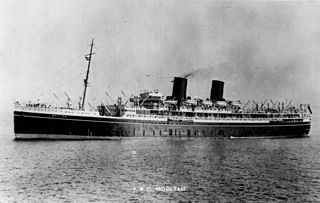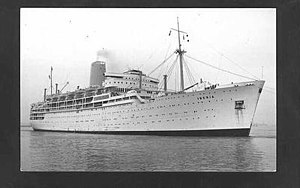
SS Canberra was an ocean liner, which later operated on cruises, in the P&O fleet from 1961 to 1997. She was built at the Harland and Wolff shipyard in Belfast, Northern Ireland at a cost of £17 million. The ship was named on 17 March 1958, after the federal capital of Australia, Canberra. She was launched on 16 March 1960, sponsored by Dame Pattie Menzies, wife of the then Prime Minister of Australia, Robert Menzies. She entered service in May 1961, and made her maiden voyage starting in June. She appeared in the 1971 James Bond film Diamonds Are Forever. In the 1982 Falklands War she served as a troopship. In 1997 the singer and songwriter Gerard Kenny released the single "Farewell Canberra" which was specially composed for the last voyage.

SS Himalaya was a British passenger ship of the Peninsular and Oriental Steam Navigation Company, launched in 1948, which operated mainly between Britain and Australia. She was withdrawn from service in 1974 and scrapped the next year.

SSOriana was the last of the Orient Steam Navigation Company's ocean liners. She was built at Vickers-Armstrongs, Barrow-in-Furness, Cumbria, England and launched on 3 November 1959 by Princess Alexandra. Originally resplendent with her owners' traditional corn-coloured hull, Oriana appeared as an Orient Line ship until 1966, when that company was fully absorbed into the P&O group. Faced with unprofitable around-the-world passenger routes, the P&O white hulled Oriana was operated as a full-time cruise ship from 1973. Between 1981 and her retirement from service five years later, Oriana was based at Sydney, Australia, operating to Pacific Ocean and South-East Asian ports. Deemed surplus to P&O's requirements in early 1986, the vessel was sold to become a floating hotel and tourist attraction, first in Japan and later in China. As a result of damage sustained from a severe storm whilst in the port of Dalian in 2004, SS Oriana was finally sold to local breakers in 2005.

P&O Cruises is a British cruise line based at Carnival House in Southampton, England, operated by Carnival UK and owned by Carnival Corporation & plc. It was originally a subsidiary of the shipping company P&O and was founded in 1977. Along with P&O Cruises Australia, another former subsidiary of P&O, it has the oldest heritage of any cruise line in the world, dating to P&O's first passenger operations in 1837.

The Turbine Steamship Fairsky was a one-class Italian-styled passenger ship operated by the Sitmar Line, best known for service on the migrant passenger route from Britain to Australia from May 1958 until February 1972. After a 20-month lay-up at Southampton, Fairsky completed two further voyages to Australia, before returning to be based at Sydney as a popular full-time cruise ship, until striking an unmarked wreck in 1977 which rendered the vessel uneconomic to permanently repair. The ship was finally sold to a Philippines based consortium, intended for static use as a casino and floating hotel. In 1979 during refurbishment at Manila Bay for her new role, a fire broke out onboard which destroyed the accommodation. The wreck was towed to Hong Kong for demolition in 1980.

SS Arcadia was a passenger liner built for P&O in 1953 to service the UK to Australia route. Towards the end of her life she operated as a cruise ship, based in Sydney, until scrapped in 1979.

The Orient Steam Navigation Company, also known as the Orient Line, was a British shipping company with roots going back to the late 18th century. From the early 20th century onwards, an association began with P&O which became 51% shareholder in 1919 and culminated in the Orient Line being totally absorbed into that company in 1966.

The SS Mongolia was a steam turbine-driven twin-screw passenger-and-cargo ocean liner launched in 1922 for the Peninsular and Oriental Steam Navigation Company (P&O) for service from the United Kingdom to Australia. Later in P&O service she sailed for New Zealand, and in 1938 she was chartered to a P&O subsidiary, the New Zealand Shipping Company, as SS Rimutaka.

RMS Mooltan was an ocean liner and Royal Mail Ship of the Peninsular and Oriental Steam Navigation Company (P&O). She was ordered in 1918 and completed in 1923. She served in the Second World War first as the armed merchant cruiser HMS Mooltan (F75) and then as a troop ship. She was retired from P&O service in 1953 and scrapped in 1954.

SS Oronsay was the second Orient Line ship built after World War II. A sister ship to Orcades, she was named after the island of Oronsay off the west coast of Scotland.

SS Orsova was a steam ocean liner owned by the Orient Steam Navigation Company. She was built by John Brown & Company at Clydebank, Scotland in 1909 to operate a passenger service between London and Australia. Her maiden voyage was 25 June 1909.

SS Orsova, was a British ocean liner, built by Vickers Armstrong in Barrow-in-Furness, England for the Orient Steam Navigation Company for their Great Britain-to-Australia services via the Suez Canal. She was the final development of the 28,000 ton class which began with the SS Orcades of 1948 and continued with the SS Oronsay of 1951. In 1960, in conjunction with the introduction of the new larger and faster Oriana and Canberra, the fleets of Orient and P&O were combined as P&O-Orient Lines, although the Orient ships retained their corn-coloured hulls and sailed under their own house flag. In 1966, P&O acquired the balance of the Orient shares and the Orient Line was discontinued, with Orsova and her fleet mates being transferred to the ownership of the Peninsular & Oriental Steam Navigation Company (P&O), painted white and under the P&O houseflag.

HMS LST 3519 was a Landing Ship, Tank of the Royal Navy, entering service during the last months of the Second World War. She was chartered for civilian service as the Empire Baltic from 1946, serving as an early RO-RO ferry until the navy suspended the charter and requisitioned the ship during the Suez Crisis in 1956. She briefly returned to normal service, but was retired soon after and was eventually sold for breaking up.
The SS Chusan was a British ocean liner and cruise ship, built for the Peninsular and Oriental Steam Navigation Company's Indian and Far East Service in 1950. She was named after Chusan, a small island off China. A smaller version of the SS Himalaya, the Chusan had a gross register tonnage of 24,215; and a capacity of 1,565 passengers and crew. She was built as a replacement for the RMS Viceroy of India, lost in the Second World War. She was 646.5 feet (197.1 m) long. The Chusan is said to have brought new standards of shipboard luxury to India and the Far East. She was the last passenger liner built for P & O by Vickers-Armstrongs.

SS Königin Luise was a Barbarossa-class ocean liner built in 1896 by Vulcan Shipbuilding Corp. of Stettin, Germany, for the North German Lloyd line of Bremen. She served on the company's Australian, Far East, and North Atlantic routes for nearly two decades.

Lavia was a cruise ship that caught fire and sank in Hong Kong Harbour in 1989. She was built for Cunard White Star Line in 1947 as the cargo liner Media. In 1961 she was sold to Italy, rebuilt as an ocean liner and renamed Flavia. In 1969, she was refitted as a cruise ship and renamed Flavian. In 1982 she was sold to Panama and renamed Lavia. She was undergoing a refit when the fire occurred. The damage to her was so great that she was scrapped.

This article is primarily about the third ship to bear this name, however there were two previous ships : SS Nevasa and HMT/HMHS Nevasa. All three ships were operated by the British India Steam Navigation Company.

RMS Asturias was a Royal Mail Lines ocean liner that was built in Belfast in 1925. She served in the Second World War as an armed merchant cruiser until she was crippled by a torpedo in 1943. She was out of action until 1948 when she returned to civilian service as an emigrant ship. She became a troop ship in 1954 and was scrapped in 1957.

SS Osterley was a steam ocean liner owned by the Orient Steam Navigation Company. She was built by the London and Glasgow Shipbuilding Company at Clydebank, Scotland in 1909 for a passenger service between London and Australia via the Suez Canal.

SS Stratheden was a UK-built steam turbine ocean liner. She spent most of her career with the Peninsular and Oriental Steam Navigation Company, including the Second World War when she served for six years' as a troop ship.


















